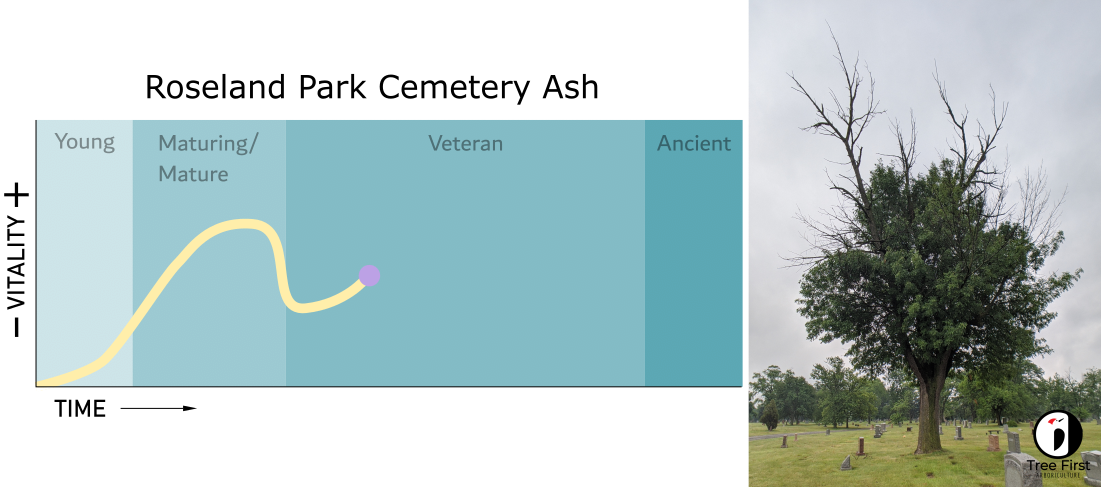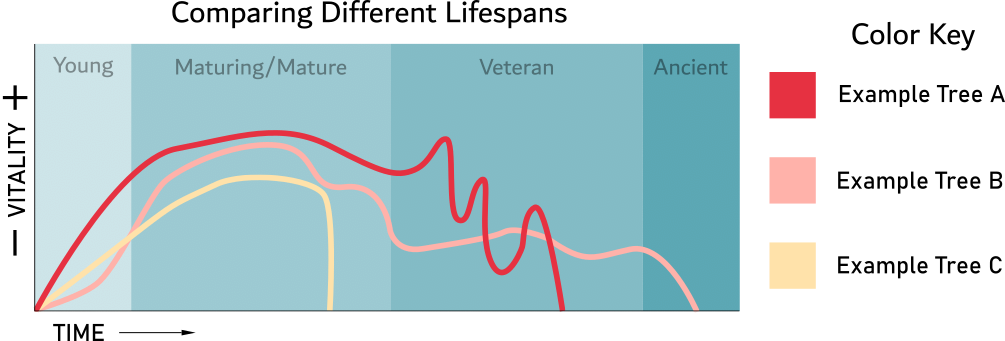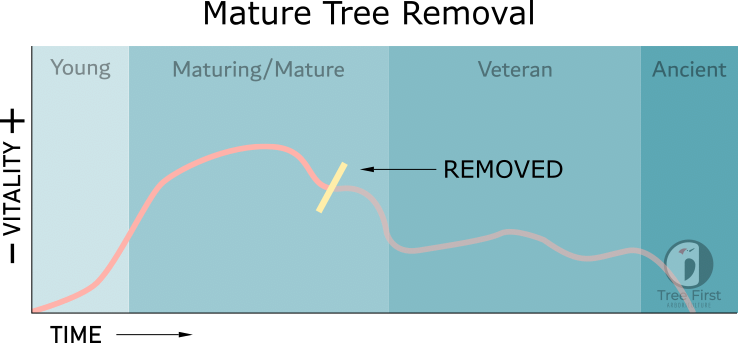I think my tree is just getting old and dying.
Our tree has started to lose some limbs, so we think it's time for it to go.
The tree is looking a little thin...
Music to the ears of plenty of tree companies that use a chainsaw to solve all tree-related problems. Saying these kinds of things to a tree cutter does the hardest part of their job–convincing the homeowner to hire them.
Valuable mature and valuable veteran trees are routinely cut down or maimed, despite other affordable and mindful options for keeping less-than-perfect trees alive and safe.
It is true; some folks are afraid of trees and would rather see them gone from their property. It is also true that some trees should come down. It is true too, that there are folks out there that just want to cut trees down.
But there is another population of people who have removed trees from their properties begrudgingly because an arborist or tree cutter told them (or agreed) they should come down. Rather than steer the conversation towards problem-solving or educating, they often instead steered homeowners directly towards removal.
It is a quick and simple solution where the chainsaw is the solution to every problem. Come on. It’s 2022.
We ought to be Taking Care of Trees
There is a lack of understanding on both sides of the equation. Most homeowners aren’t tree biologists; at the same time, having a thorough grasp of tree biology is not required to becoming a arborist or tree trimmer. Keeping old trees alive through patience and careful nuance isn’t a lucrative practice for most Big Arb tree companies, but cutting them down certainly is.
It is a crime against nature not to revere older and veteran trees. Losing these trees results in significant loss of wildlife habitat, loss of thousands of dollars for homeowners, and most importantly, the loss of valuable old trees themselves. Tree lifespans are not as simple as ‘getting old and dying.’ Tree biology is very complex, becoming increasingly complex as they age.
Goals of this Article
Tree life span concepts are applicable to anyone thoughtful about trees. The two focuses of this article are:
Identifying and broadly examining different life stages of trees
Contextualizing where the tree is along its lifespan with simple visuals
The tree’s life stage determines how the tree should be managed, while its timeline is used to give it context. Both are combined into a visual model in Section 2 of this article.
With these visual models of tree life spans, communicating and thinking about trees can be easier. The intent of these models is to promote stewardship by illustrating that trees can have a future; a way of thinking about trees that automatically takes their future into account.
Section 1 | Life Stages
Identifying the life stage of a tree is the first thing to make clear when examining a tree for any reason. Categorizing the tree’s age makes certain observations make sense. It is normal for an old veteran tree to have lots of dead wood–not so normal for a sapling, for example.
Trees are often abused with over pruning and damage to their roots, which reduce tree vitality. They often grow in extremely difficult soil environments in the urban landscape. The tree’s life stage will also contribute to its capacity to respond to the conditions they are in.
The following subsections briefly describe a tree in their respective stage, along with general things we can do to benefit them while they’re in that stage. Each subsection includes a snippet from a comprehensive infographic, which can be seen in whole at the end of this article.
There are four(ish) broad stages a living tree can go through: Seedling/Sapling, Maturing/Mature, Veteran, and Ancient. Each of these could likely be subdivided too.
We place emphasis on the veteran, ancient, and dead phases, as those trees in those phases are the most misunderstood and undervalued and are not awarded the privilege of life.
Seedling/Sapling Trees
Trees in the youngest stages are vulnerable, becoming more resilient as they age toward the next stages. A vast majority of these trees’ energy is used for a single purpose: growth. In this phase, focus on preventing the tree from developing dysfunction in its future.
Ensure all of the soil properties are examined and addressed. Planting a tree in an extraordinarily difficult soil environment doesn’t set the tree off on the right foot, nor do the typical malpractices that accompany most tree plantings. Structural pruning of trees is most effective while the trees are young, across several doses over many years. This prevents the forming of massive inclusions as the tree matures, for example.
Maturing Trees
Most of the ‘big’ trees we encounter in the urban forest are maturing or already mature. Often, following massive destructive events—like lot clearing and urban development, chestnut blight, and dutch elm disease—many trees are planted en masse. This is why we often see distinct age groups in the landscape. For example, a future generation of maturing/mature urban trees in the American midwest likely were planted en masse following the emerald ash borer invasion in the early 2000s.
Again, all soil properties should be examined and addressed. Fertilization efforts should aim to satisfy parameters set by soil testing labs, rather than arbitrary ‘custom blends’ most companies use to fertilize trees. Soils in the urban landscape vary substantially; they all can’t have the same problems.
As trees enter maturity, their resilience and vitality peak. When working with maturing trees, your goals should aim to prolong peak maturity for as long as possible. This means minimizing both pruning frequency and destructive soil disturbances. When pruning of live tissue is necessary, keep pruning to the crown’s periphery, opting for small reduction instead of removal cuts everywhere possible. When soil disturbances are unavoidable, dig with pneumatic diggers, like Arborjet’s Airknife, rather than traditional digging tools.
Transition to Veteran
Broadly speaking, trees will transition into the veteran stage as their overall vitality begins to decline. This can happen for a myriad of complex reasons and can happen to any tree. Both chronic and acute stress increases the amount of dysfunction within the tree, which over time, reduces vitality.
Folks get the wrong impressions about big and old trees. I suspect it is the transition between mature stage to veteran stage that most urban trees see their demise to human hands.
Veteran Trees
Veteran trees are broadly characterized by their reducing vitality. Their major stems ‘slow down,’ and the amount of large dead limbs begins to increase. They will often have large areas of decay within major structural stems. What usually gets a tree owner’s attention is when something breaks.
This could still be an OK thing for the tree. Once the tree has been confirmed to be a veteran, a thorough assessment of the tree’s history, environment, physical structure, and wildlife present should follow. Examining each of these categories gives your management planning a large spread of information to potentially work with. Veteran trees are sensitive to significant change, so the skilled and nuanced hand is required here to keep them healthy and hazard-free for any targets.
Basic considerations are the same as with mature trees: examine the soil and avoid adding undue stress onto the tree. Avoid large diameter removal cuts. Keep the tree within the stage as long as possible. Address chronic stressors the tree faces, which generally are abiotic at this point. Consistent attention and record keeping is required for managing veteran and ancient trees.
Retrenchment
A retrenching ash tree at Roseland Park Cemetery in Royal Oak, MI
This naturally occurring process can occur as part of a tree’s natural life progression. It can be either stress-induced or it can be replicated by pruning. A retrenching tree separates from large and old limbs and begins to grow a new, smaller, less energetically expensive crown from within. The industry-standard practice of arbitrarily removing ‘suckers’ hinders this process, which can exacerbate stress or even lead to mortality.
It is surprisingly common to find retrenching trees in the urban and suburban environment. They are not rare. And it is very common to see trees striped of all of their interior growth, unfortunately.
There are broad symptoms that, when combined, indicate a tree is retrenching. I speculate patterns of retrenchment exist that are species-specific, too. An oak may have different retrenchment physiology than a maple, for instance.
A tree expressing symptoms of retrenchment can indicate the tree is either entering into or is already within the veteran stage. Retrenching is not required for a tree to be a veteran, however.
On the other hand, sometimes stressors are so traumatic and acute that the tree lacks the resources or time to mount a retrenching response. In this case, the tree could be in terminal decline. That tree may be beyond the point of meaningful intervention.
An important variable to consider is the length of time a can retrench for.
This timeline shows a profound transition happening over 100 years. From A Lifespan Approach, Fay, Dujesiefken, de Berker, de Groot
Whether retrenchment happens over a century or over 20 years, we have to be able to recognize what is going on. I speculate that failing to recognize when a tree is undergoing retrenchment could be a leading reason for tree condemnation—a classic and expensive misdiagnosis.
Removing maturing and veteran trees is acceptable if they pose an excessive risk to us, and if their risk cannot be reduced by other means. It is an unfortunate norm in our industry to condemn trees quickly. Those decisions should only be made after thorough assessments and contemplation—not from a single quick glance.
Ancient Trees
Unlike veteran trees, we almost never encounter ancient trees in the landscape. But similar to their time spent as veterans, ancient trees are highly sensitive to significant change. Ancient trees do not necessarily have to be very old. An ancient birch is not as old as an ancient oak. A requisite for being in this stage is to have passed through the other stages.
The same nuanced and gentle hand is required for managing ancient trees. Nearly all of the work at this stage focuses on minimizing chronic stressors from the tree’s environment.
Dead Trees
Dead trees (and dead wood in general) play a very large role in forest ecosystems as wildlife habitats. The appreciation and understanding of dead trees is becoming increasingly popular. Many species require dead wood in order to fulfill their needs. Dead trees and dead tree parts are fundamental in nutrient and carbon cycling in forests and are one of the primary sources of food for decomposers.
When left standing or fallen, their structures are important. An homage to its former living self, the dead tree deserves reverence. It is still providing for its community, long after its death.
Section 2 | Life Spans
The graph below illustrates an example tree’s vitality as it ages over time. The background indicates which life stage the tree is in, and the length of the stage will vary both by individuals and by species.
Vitality in this context could be thought of as how much of the tree is living; is the system’s needs being met by its crown, roots, and environment, is the tree experiencing a net carbon gain, is the living area increasing or decreasing, etc. You get the idea.
We usually aren’t lucky enough to witness an entire natural lifespan of a tree from start to finish. And it’s important to understand what they can look like as a whole because we can only see snapshots from a long and complex timeline.
While working with a tree, you have to not only try to predict where it is on its timeline but also what that current trajectory is. We might call that contextualizing the tree along its lifespan. I reckon there are tendencies that are species-specific here, too.
Here’s what the retrenching Roseland Park Cemetery Ash’s timeline might look like. Notice the maturing stage was fairly short due to an emerald ash borer infestation—its vitality had a steep drop, causing enough dysfunction to place the tree into its veteran stage. The maturing phase would have likely lasted much longer had this not happened. The ash experienced a large decline in vitality before rejuvenating a new crown.
No Identical Lifespans
No two lifespan lines will look the same. A tree can die at any stage, and, in theory, they can experience high or low vitality in any of the stages. Different trees remain in stages for different lengths of time. The mature stage for an oak is will last quite a bit longer than that of a horse chestnut.
Each tree’s lifespan is unique. Each crest and trough on a tree’s lifespan can be the result of external forces or can mark just a natural transition into the next stage. There are some patterns that are more predictable. I reckon most lifespans begin with increasing vitality towards maturity, while gradually trending downwards from peak maturity. As a tree enters into its veteran and ancient stages, it can experience resurgences as reiterative growth, such as Example Tree A and Example Tree B.
Nudging this tree in a positive direction with Arborjet’s Air Knife.
Sudden drops can be illustrated to show acute trauma, like a massive pruning dose or a deadly infestation. Gradual changes over time indicate chronic positive or negative influence, like soil amending or extended periods of drought.
These graphs can help visualize the tendencies of not only entire trees but of separate tree parts, too. They can experience these growth patterns and phases independently of one another, especially in the veteran and ancient stages, as the tree becomes increasingly modular.
Section 3 | Influencing the Timeline
We can’t forget: we have the power to influence the direction of a tree’s lifespan. In fact, I would argue that everything we do, or don’t do, has an influence on the tree’s lifespan, whether we intend on it or not.
When we jump straight to removal, we cleave what life span that tree could have had. The tree removed could have lived much longer. Sure it would have had decay and would need inspections and risk mitigations—I could go on and on. But that’s what tree care actually is.
Not all efforts will succeed. You may put everything towards benefitting a tree and things still can go south. That’s totally OK. It’s called a ‘practice’ for a reason.
It is part of our duty as arborists to make the effort to keep trees alive instead of going straight for our biggest saw. Jumping immediately to the remove-and-replant strategy is dated and cheap.
Example Tree:
Jeff’s Maple grows in Royal Oak, Michigan, and is under our care. This tree is somewhere within the early veteran stage. Its base is colonized by ganoderma lucidum, its roots were girdling the trunk, and we have removed leader-sized dead stems from this tree.
This retrenchment response is well underway. The cause(s) of retrenchment here aren’t currently certain but are likely a combination of urban stress and ordinary age-related causes. The generation of the lower crown is occurring at a rate that appears to match the rate the upper crown is declining. So we might say its vitality changes are happening gradually (for now). This tree is dying back, but clearly has plenty of vitality. It is doing what a healthy veteran tree should do—a fantastic example of early retrenchment.
The tree is being provided a prescriptive fertilizer regime that aims to strengthen the soil’s biological properties. Pruning is restricted to only dead wood for the time being as we allow the retrenchment process to happen on its own.
We don’t know what exactly the future of this tree will look like, our models can’t be pinpoint precise. The models do, however, allow us to illustrate to ourselves and customers, a positive trend.
Section 4 | A Human Duty
Visualizing a tree’s lifespan in this way acknowledges its great capacity for adapting and changing. The tree is a dynamic thing; it is in motion. Very slow motion. And we can’t forget that. When we look at trees, they are doing something; they aren’t just big green background.
Identifying the tree’s life stage and where it could be on its timeline can serve as a backbone to a tree’s management plan: all of the planning surrounds the model presented in this article. What direction do we want things to go in?
Taking care of trees is all about making decisions; and you have the capacity to influence nature in a positive way. You probably won’t be able to witness the tree’s full lifespan. You won’t be thanked by the tree. But how awesome a thing to be able to influence big old trees? To be given this kind of trust is the pinnacle of arboriculture. You are playing a part in that, and you ought to take it more seriously.
This article is in the spirit of shifting the needle towards conscientious and comprehensive tree care being the norm, and away from mindless cutting. I hope the model illustrated here is a useful tool for you and the way you treat trees. Take more than a moment when looking at trees. They deserve it.














